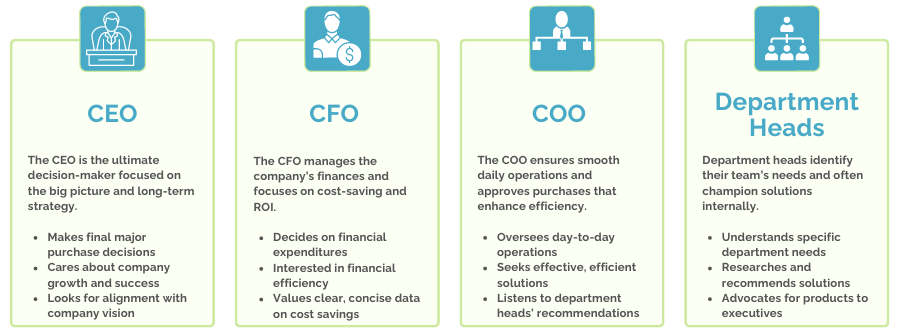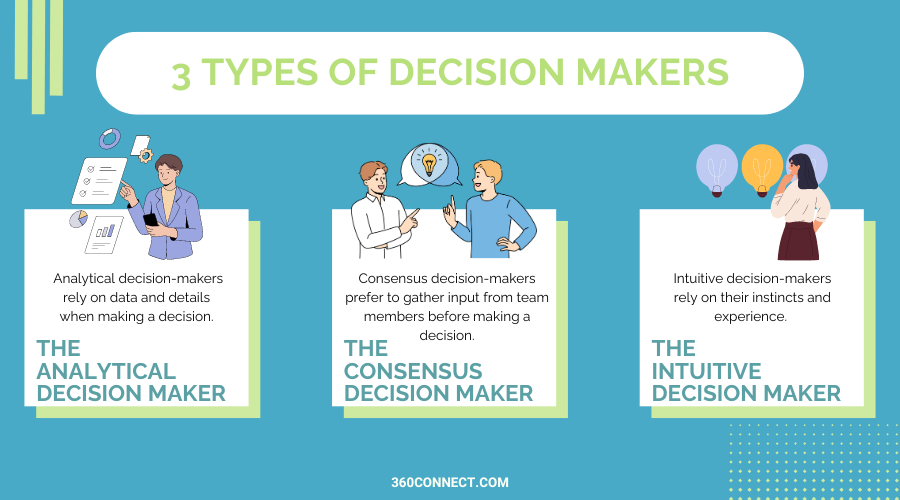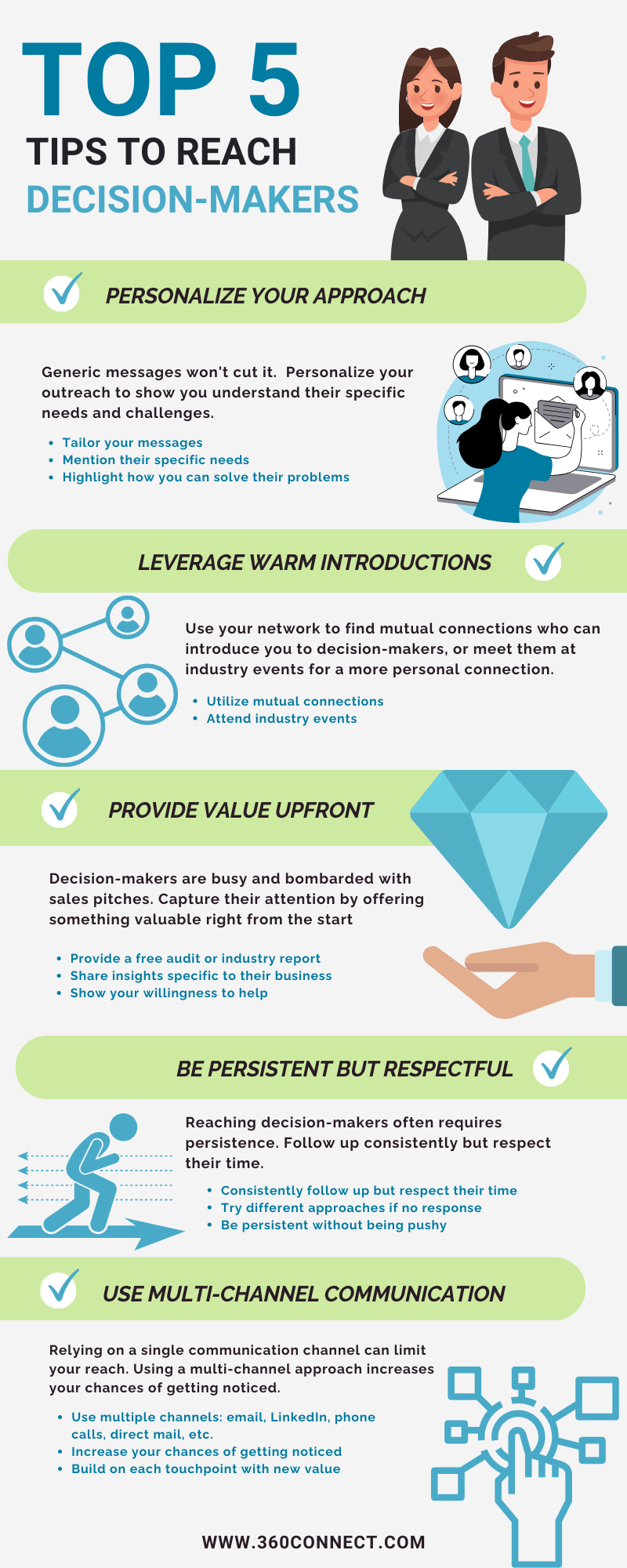Tired of talking to people who have no power to make decisions? You’re not alone, that’s why we’re here to give you the tips you need to reach B2B decision-makers. We won’t waste your time like gatekeepers do, so let’s get straight into why you’re here and provide you with the information needed to succeed.
In the competitive world of B2B sales, reaching the right person makes all the difference. This guide will provide you with the information needed to reach key B2B decision-makers. We’ll be going over who the key decision-makers are, how to identify decision-makers, how to get around gatekeepers, and the top 5 tips to reach decision-makers. Let’s get started.
Key Takeaways
- Know Your Decision Makers: Understand the roles and decision-making styles of CEOs, CFOs, COOs, and department heads to effectively tailor your outreach.
- Use Personalized and Strategic Outreach: Personalize your approach and leverage warm introductions to make meaningful connections with decision-makers.
- Overcome Gatekeepers: Develop strategies to navigate around gatekeepers, ensuring your message reaches the key decision-makers directly.
Who are Key B2B Decision Makers?
So, who are your decision-makers? In general, decision-makers are the people who have the authority to make a purchasing decision. Typically this falls on the following:
- CEO (Chief Executive Officer)
- CFO (Chief Financial Officer)
- COO (Chief Operating Officer)
- Department Heads
But, you probably already knew this. Knowing is the first step, and understanding is the next.
Understanding B2B Decision Makers
So, you know who the key players are, but do you know the reality of their roles and decision-making power? The following is just a relay of what typically goes on within each role to help you better understand your decision-makers, where their mindset is, and how you can reach them.

CEO
The CEO, to sum up, is the big boss who makes the ultimate decisions on major purchases. Often this is just a final check off of approval. Their mind is on the big picture and long-term strategy, so if a solution can aid that they’re all ears. So, when approaching a CEO, keep in mind that all they really care about is how the solution will impact the company’s future growth and success. They don’t need the pain point email or to know the nitty-gritty of what the solution does; they just want to know how it aligns with their vision and goals.
CFO
The CFO handles the money and decides what the company spends on. However, you wouldn’t send them a product or solution that they are completely unaware that they even need. Instead, focus on messaging around cost-saving, ROI, and financial efficiency. These are people who care about money and the bottom line, they appreciate clear, concise data that shows how your solution will save the company money.
COO
The COO ensures that daily operations run smoothly and approves purchases that will help with that. Unlike the first two, the COO is very well versed in what solutions will help the company and is likely hearing this from department heads. Their goal is to provide their company and team with efficient and effective solutions. So, when talking to a COO, highlight how your product or service can streamline operations.
Department Heads
Next up are department heads, these are your decision-makers who are in the weeds regarding what the company really needs. They will usually be tasked with finding the solutions the company and their department needs, and either making the decision or making a case for the solution to the executives. This is where you use the pain point messaging. When reaching out to these decision-makers you need to tailor your messaging to their specific needs and how you’re the solution. Remember, they are often the champions who will advocate for your product internally so do not dismiss this group of “decision-makers”.
Reach Decision Makers with 360Connect
We source high-quality, true-intent prospects and deliver them directly to you daily. Don’t miss out on the opportunity to connect with the right people and grow your business. Get started today!

Types of Decision Makers
You know who makes the decisions and their job titles, you’re ready to reach out right? Wrong. Even understanding the decision-maker’s role, you’ll also need to know what TYPE of decision-maker you’re dealing with.
Job titles are one thing, but the type of person they are is another. So while you may be able to craft the perfect email that aligns with a CFO, it will mean nothing if you never determined what type of decision maker they are. Here are the three main types of decision-makers:

1. The Analytical Decision Maker
Show them the numbers. Analytical decision-makers rely on data and details when making a decision. They need comprehensive information and are often meticulous about details.
- Requires thorough research and data
- Values detailed reports and clear evidence
- Prefers structured and logical presentations
Tip: Provide an industry report, insights, etc.
2. The Consensus Decision Maker
These are your decision-makers who you’ll likely have lively conversations with. They enjoy communicating and collaborating as much as they like deciding on major purchases with others. Consensus B2B decision-makers prefer to gather input from various team members before making a decision. They value collaboration and team alignment.
- Seeks input from others
- Values team consensus and collaboration
Tip: Connect with their associates on social media to make yourself a trusted source to those they will ask for input from.
3. The Intuitive Decision Maker
Intuitive decision-makers rely on their instincts and experience. They make quick decisions based on gut feeling and overarching patterns.
- Trust instincts and experience
- Values quick and decisive action
- Prefers high-level overviews and broad strategies
Tip: Provide value upfront to these decision-makers, if you have their solution they’ll know.
Understanding these types will help you tailor your approach even further, ensuring your communication style matches their decision-making process.
How to Identify Decision Makers
While it may be hard to believe, things can often be as simple as they seem. This is the case when it comes to identifying decision-makers. If you’re looking to find the right people, there are a few straightforward methods.
If you’re looking for a professional who can make decisions—LinkedIn is your best friend. Using LinkedIn’s advanced search options you can filter and find people based on their job titles…like CEO, CFO, and COO. It’s an easy way to directly connect with the B2B decision makers you’re after.
Company Website
Interested in a specific company that you know can benefit from your product, or have a lead going cold and want to just talk to the decision maker already? Well, why not check out their website? Most companies list their leadership team and key personnel on their “About Us” pages. This gives you a direct line to the top players.
Form Fill-Outs
When you have potential clients filling out forms on your website, ask for their job titles. This helps you identify if the person reaching out is in a decision-making position.
Networking and Events
Don’t underestimate the power of networking. Industry events, trade shows, and conferences are great places to meet and identify decision-makers. A face-to-face introduction can sometimes work wonders.
By using these methods, you can cut through the noise and get directly to the people who have the power to say “yes” to your solution.
The Top 5 Tips to Reach Decision Makers
Now that you know, can identify, and better understand who the key decision makers are, it’s time for us to reveal the strategies on how to effectively reach them. Reaching the right decision-maker can feel like you’re stuck in a corn maze. But with these top 5 tips, we’ll help guide you on the path to success.

1. Personalize Your Approach
Generic messages won’t cut it. We’re telling you right now and hope you heed our warning that when it comes to decision makers you CANNOT send them generic sales messaging. These are high-level decision-makers, and each is different. Take the time to research each individual and tailor your approach accordingly. Personalize your emails or any other form of outreach to showcase that you’ve done your homework and are someone they can trust to do business with. Essentially, decision-makers appreciate when you speak their language.
- Email open rates increase by 26% when personalization is used.
In addition to personalizing your approach, we recommend getting personal with them. Reaching decision-makers comes down to personal connections. Follow them on social media, engage with their posts, and share relevant content. This way when you finally reach out, they’ll be able to reference your prior interactions. They see you as trustworthy and a personal contact to do business with.
Remember, the goal is to stand out in a sea of generic pitches.
2. Leverage Warm Introductions
If you feel like you’re shouting into a void when emailing or cold calling, then it’s time to leverage warm introductions. Make use of your network and find mutual connections who can introduce you to the B2B decision-makers you’re trying to reach. A recommendation from someone they know and trust can significantly increase your chances of getting a positive response.
- More than 90% of B2B buying decisions are influenced by peer recommendations, and 84% of buyers start with a referral.
Don’t have mutual connections? Well, to put it lightly, make them. Consider attending industry events and networking opportunities where you’ll be able to either meet common people in the inner circle or meet the decision-makers directly. A face-to-face introduction at a conference or trade show can make a lasting impression. Follow up after the event with a personalized message reminding them of your conversation and how your solution can help their business.
3. Provide Value Upfront to B2B Decision Makers
Trying to reach a decision-maker is synonymous with trying to reach a busy person. In addition, their inbox is full of sales pitches similar to the ones you’re sending, constantly bombarding them. Can you blame them for not giving you a chance? If you’re not providing value upfront, you’re just another email filling up their inbox.
- 80% of leaders feel they have too much data to weigh up when making decisions.
- 63% of business leaders spend upwards of 40 hours a week exclusively on making decisions.
To capture their attention, offer value right from the start. This could be a free audit, a valuable piece of content like an industry report, or insights specific to their business. Providing value upfront demonstrates your expertise and willingness to help without asking for anything in return… initially.
4. Be Persistent But Respectful
Reaching B2B decision-makers often requires persistence. They are busy and may not respond to your first attempt, or second, or even third. Make sure to follow up consistently but be respectful of their time. If you’ve sent an email and haven’t received a response, try a different approach. Maybe send a LinkedIn message, the point is to be persistent but not a bother. Nobody hires a business that they find annoying. Being persistent without being pushy is key. Show that you’re dedicated and ready to assist, but always respect their space and schedule.
Related: Why Persistence is Key to Closing Sales
5. Use Multi-Channel Communication
Relying on a single communication channel can limit your reach. Decision-makers have different preferences for how they receive information, so using a multi-channel approach increases your chances of getting noticed. Combine email, LinkedIn, phone calls, and even direct mail to create an outreach strategy they’ll be sure to notice.
- Engagement rates jump 166% for businesses using two or more channels.
For example, start with an email introducing yourself and your solution, follow up with a LinkedIn connection request, and then a personalized message. If you still haven’t heard back, try a phone call. Each touchpoint should build on the last, providing new value or information to keep the conversation progressing. Mixing up your methods shows that you’re serious and willing to go the extra mile to connect.
How to Get Around Gatekeepers
You have the tips you need to reach decision-makers! You know what you need to do to succeed and you’re ready to reach those sales goals. But then, you run into… a gatekeeper. What now?
Gatekeepers are the assistants, receptionists, or lower-level employees whose job it is to filter who gets through to the B2B decision-makers. Essentially they are the bodyguards, and unless you have clearance, you’re not getting in when dealing with them. So how do you get said “clearance”?
While gatekeepers can seem like an impossible barrier, with the right strategies, you can navigate around them to reach the person you really want to connect with.
Be Respectful & Build Rapport
Decision-makers don’t want to work with a company that is rude to their team. The gatekeeper isn’t your enemy, they’re simply doing their job so be respectful and establish a relationship with them. Being courteous and friendly can go a long way.
When you’re polite and personable, gatekeepers might be more willing to pass along your message. Or even give you insider information on the best way to reach the decision-maker. Remember, they hold the keys to the kingdom, and being on their good side can be incredibly valuable.
Use the Right Language
The language you use can determine whether you get past the gatekeeper or not. Instead of saying, “Can I speak to Mr. CEO?” try being more direct, like “I need to speak with Mr. CEO regarding an important matter about [specific topic].” This approach makes it sound like you’re already expected, rather than just another salesperson trying to get through.
These are just two strategies to get you started, navigating around gatekeepers can be frustrating, but not impossible. With respect, persistence, and smart tactics you can reach decision makers.
Final Thoughts on Reaching B2B Decision Makers
Reaching B2B decision-makers isn’t easy, if it were, there wouldn’t need to be articles written about it. But with the right strategies, you can navigate this complex process effectively and reach decision-makers.
By implementing the tips we’ve shared, you can improve your chances of making meaningful connections and closing deals.
Reach Decision Makers with 360Connect
Ready to take your B2B sales to the next level? At 360Connect, we specialize in connecting suppliers with high-quality buyers. Don’t miss out on the opportunity to connect with the right people and grow your business. Get started today!

